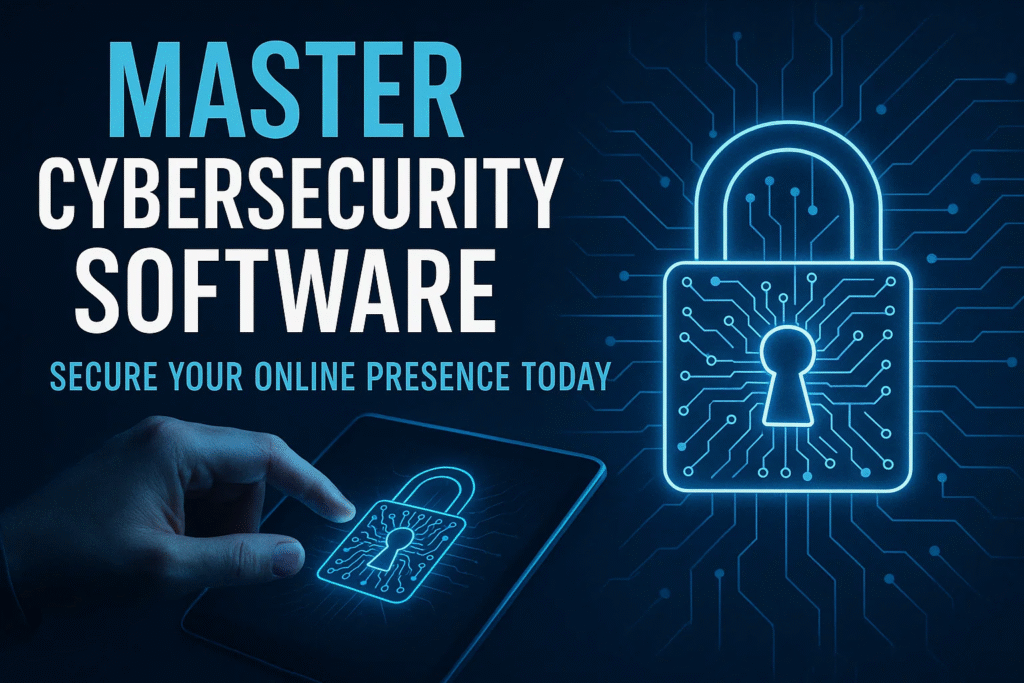In today’s digital-first era, cybersecurity isn’t just a technical term — it’s a necessity. Whether you’re a small business owner, a freelancer, or a casual internet user, your online security defines your credibility, privacy, and peace of mind. With the surge of online transactions, cloud computing, and data-driven business operations, protecting your digital assets has become more crucial than ever.
But how do you safeguard yourself in a world where cyber threats evolve every single day? The answer lies in mastering cybersecurity software — the shield that guards your online presence from hackers, phishing scams, malware, and data breaches.
In this detailed blog, we’ll explore what cybersecurity software is, how it works, key features, types, benefits, and practical strategies to protect your digital footprint effectively.
1. Understanding Cybersecurity Software
Cybersecurity software refers to tools and technologies designed to protect your computer systems, networks, and online accounts from malicious attacks. These tools detect, prevent, and neutralize threats like viruses, ransomware, spyware, phishing, and unauthorized access.
It acts as a digital bodyguard, continuously monitoring your data and activities to ensure that no harmful or suspicious behavior goes unnoticed.
Cybersecurity software isn’t limited to just antivirus programs anymore — it now includes firewalls, VPNs, password managers, anti-ransomware tools, and endpoint protection systems.
2. Why Cybersecurity Matters More Than Ever
The digital world has expanded faster than anyone could have imagined. From remote work setups to IoT-enabled devices and AI-driven platforms, our reliance on technology has made us more vulnerable than ever.
Here’s why cybersecurity has become the backbone of the modern digital ecosystem:
-
Data Privacy Threats: Every online activity leaves a digital trace. Cybercriminals exploit these traces to steal personal or financial data.
-
Rising Cybercrime: Global cybercrime costs are expected to exceed $10 trillion annually by 2025.
-
Remote Work Vulnerabilities: Home networks often lack the security infrastructure that corporate systems have.
-
Phishing & Social Engineering: Scammers manipulate users into revealing confidential information through fake websites or emails.
-
Reputation Management: A single data breach can damage an individual’s or organization’s reputation permanently.
In short, cybersecurity is no longer optional — it’s essential.
3. Key Types of Cybersecurity Software
Different software tools serve different purposes. Understanding them helps you build a strong digital defense strategy.
| Type of Cybersecurity Software | Primary Function | Best For |
|---|---|---|
| Antivirus Software | Detects and removes malware, viruses, and trojans. | Individual users, small businesses |
| Firewall | Blocks unauthorized access while allowing legitimate traffic. | Networks and servers |
| VPN (Virtual Private Network) | Encrypts internet connections to secure online communication. | Remote workers, travelers |
| Anti-Ransomware Tools | Protects data from ransomware attacks. | Businesses handling sensitive data |
| Password Manager | Generates and stores strong passwords securely. | Individuals managing multiple accounts |
| Endpoint Protection Platform (EPP) | Provides centralized security for all connected devices. | Enterprises and IT departments |
| Intrusion Detection System (IDS) | Monitors network traffic for suspicious activity. | Corporations, government agencies |
| Email Security Software | Filters phishing and spam messages. | Organizations relying heavily on email |
| Cloud Security Tools | Protects data and apps hosted on cloud servers. | SaaS providers, enterprises |
| Mobile Security Apps | Guards smartphones from malicious apps and network threats. | Mobile users and remote employees |
4. Core Features to Look for in Cybersecurity Software
When selecting cybersecurity software, it’s not just about the brand — it’s about the features that align with your needs. Below are the essential elements you should look for:
-
Real-Time Threat Detection: Continuous scanning for potential risks and immediate alerts.
-
Automatic Updates: Regular updates ensure the software can combat the latest threats.
-
Encryption Support: Ensures your sensitive data remains unreadable to unauthorized parties.
-
Multi-Device Protection: Coverage across PCs, laptops, smartphones, and tablets.
-
User-Friendly Dashboard: Simplified control panels that even non-technical users can manage.
-
Behavioral Analysis: Monitors user behavior to detect anomalies like unusual logins or file access.
-
Backup & Recovery: Secure data backups to restore systems after attacks.
-
Cloud Integration: Security solutions that adapt to cloud-based operations.
-
AI & Machine Learning Support: Intelligent detection that improves with time.
-
24/7 Customer Support: Assistance whenever you face technical or security issues.
5. How Cybersecurity Software Works
At its core, cybersecurity software uses a layered defense approach to detect, prevent, and respond to cyber threats.
-
Detection: Monitors data packets, network behavior, and file systems for irregularities.
-
Prevention: Uses firewalls, encryption, and access control to stop threats before they infiltrate systems.
-
Response: Identifies infected files or endpoints and isolates them to prevent spreading.
-
Recovery: Restores affected systems from backups or secure archives.
-
Learning: Many modern tools use AI to analyze attack patterns and strengthen defense mechanisms automatically.
This systematic process ensures that even if one layer fails, others remain active to protect your digital assets.
6. The Benefits of Using Cybersecurity Software
The right cybersecurity software doesn’t just prevent attacks — it empowers you to operate confidently online. Let’s explore its key benefits:
-
Data Protection: Safeguards personal, financial, and confidential business data.
-
Financial Security: Prevents financial losses from phishing or ransomware attacks.
-
Enhanced Productivity: Eliminates system downtime caused by malware or viruses.
-
Peace of Mind: You can browse, transact, and work online without constant fear.
-
Compliance: Helps organizations meet data protection regulations (like GDPR or HIPAA).
-
Improved System Performance: Many tools optimize system health alongside security.
-
Protection Across Devices: A unified security shield for your desktop, laptop, and mobile.
7. Cybersecurity Software in Action: Real-World Use Cases
Cybersecurity software plays a vital role across industries and user levels. Let’s look at some examples:
| Sector | Cybersecurity Use Case | Outcome |
|---|---|---|
| E-commerce | Protects online transactions and customer data. | Increased customer trust & reduced fraud. |
| Banking & Finance | Uses encryption and monitoring systems. | Prevents identity theft and fraudulent transfers. |
| Healthcare | Secures patient records and hospital databases. | Maintains patient confidentiality. |
| Education | Safeguards student data and online learning portals. | Ensures secure e-learning environments. |
| Government | Protects sensitive policy and defense data. | Strengthens national cybersecurity. |
| Remote Work | VPN and multi-factor authentication. | Enables safe remote connectivity. |
8. Common Cybersecurity Threats You Must Know
Even with advanced software, awareness is the first step to defense. Some of the most common cyber threats include:
-
Phishing: Deceptive emails or websites designed to steal credentials.
-
Malware: Harmful programs that damage systems or steal information.
-
Ransomware: Locks files until a ransom is paid to the attacker.
-
Spyware: Secretly monitors user activity and collects sensitive data.
-
DDoS Attacks: Floods a system or network with traffic, causing downtime.
-
Man-in-the-Middle Attacks: Intercepts communication between two parties.
-
SQL Injection: Exploits database vulnerabilities to extract information.
-
Zero-Day Exploits: Takes advantage of unknown software flaws.
Recognizing these threats helps you deploy the right cybersecurity solutions.
9. Best Practices for Using Cybersecurity Software Effectively
Even the best cybersecurity tools need proper usage to be effective. Follow these practices:
-
Update Regularly: Always install the latest software patches.
-
Use Strong Passwords: Combine letters, numbers, and symbols for better protection.
-
Enable Multi-Factor Authentication (MFA): Adds an extra verification step.
-
Avoid Public Wi-Fi: Use a VPN when accessing sensitive data in public.
-
Backup Data Frequently: Keep copies of important files offline or on secure cloud storage.
-
Educate Your Team: Human error is still the leading cause of data breaches.
-
Limit Access Controls: Only authorized users should access sensitive systems.
-
Monitor Logs & Alerts: Stay aware of unusual activity.
-
Use Encrypted Communication Tools: Protect emails and messages.
-
Regular Security Audits: Test your system’s defenses periodically.
10. How to Choose the Right Cybersecurity Software
Choosing the right cybersecurity software depends on your needs, budget, and technical setup. Here’s a quick decision framework:
| Criteria | Consideration |
|---|---|
| Type of User | Individual, small business, or enterprise |
| Budget | Free basic protection vs. premium features |
| Devices | Cross-platform (Windows, macOS, Android, iOS) |
| Features | Antivirus, VPN, firewall, parental control, etc. |
| Ease of Use | Simple dashboards and automation options |
| Customer Support | Availability of real-time help |
| Scalability | Ability to add more devices or users later |
| Reputation | Reviews, certifications, and performance track record |
A thoughtful evaluation ensures you invest in software that truly enhances your security posture.
11. The Future of Cybersecurity Software
The world of cybersecurity is continuously evolving. With the rise of AI, blockchain, and quantum computing, security systems are becoming smarter and faster. Future cybersecurity tools will focus on:
-
Predictive Analysis: Identifying threats before they happen.
-
Zero Trust Architecture: Assuming every connection is untrusted until verified.
-
Decentralized Identity Systems: Giving users control over personal data.
-
AI-Powered Detection: Self-learning algorithms that adapt to new threats.
-
Automation: Reduced human dependency for faster response times.
-
Integration with IoT Security: Protecting interconnected smart devices.
These advancements will redefine how we think about digital safety.
12. Final Thoughts: Take Charge of Your Digital Security
In the connected world, your online presence is your identity. Whether you’re a student managing personal data or an entrepreneur handling customer records, you can’t afford to ignore cybersecurity.
Cybersecurity software acts as your first line of defense — constantly scanning, detecting, and neutralizing threats before they can cause harm. The goal isn’t just to avoid danger; it’s to build digital confidence — the ability to explore, transact, and grow online without fear.
Now is the time to invest in your security. Because in the digital world, prevention is always better — and far cheaper — than cure.


